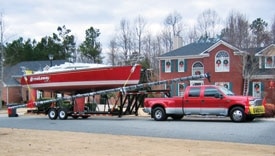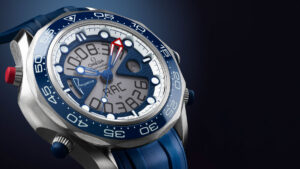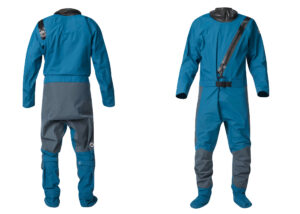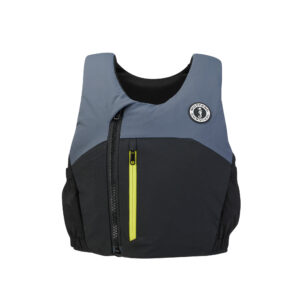
TraileringStory
You may never know how good (or bad) you are at racing your boat until you leave your home waters and test yourself against sailors somewhere else. This is a relatively easy task for dinghy sailors, a bit more of an endeavor for keelboat racers. To entice you to expand your horizons, we talked with two road warriors, guys who have trailered their boats thousands of miles in pursuit of silver and new venues.
Mike Ingham, of Rochester, N.Y., has towed his J/24 as far as central Mexico, because he’s a firm believer in sailing his own boat no matter where he races. “When I first got into J/24 racing, we chartered a boat for the worlds and it was a horrible experience,” says Ingham. “Our philosophy ever since has been, ‘That’s a really long way to go to have a really crappy boat.'”
The key to ensuring any road trip goes smoothly, says Ron Hyatt, of St. Petersburg, Fla., who sails with a program that recently upgraded from a Henderson 30 to a Melges 32, is to prepare. “I’ll set time aside before a trip to make sure everything’s ready, and I’ll check out everything on the trailer, from tires to tie-downs, make sure the boat’s clean and in good repair. We tell the dealership we’re headed for a road trip and ask them to perform any scheduled maintenance and double-check that everything’s working well on the tow vehicle.”
And what makes the perfect tow vehicle? Both of our road warriors like Chevy Suburbans. “You’ve got to have enough horsepower to tow your boat easily,” says Ingham. “We towed our J/24 to Mexico with a standard, two-wheel drive pickup, and on upgrades, we’d have to shift down to first gear.”
Space in the pickup was also a problem. It was uncomfortable with three people in the truck’s cab, and the back, while protected by a cap, was unbearably hot. I found a used Suburban with about 70,000 miles on it for less than $10,000. Now we have plenty of power, and an area large enough for the guys to sleep.”
Hyatt’s program has a brand-new Suburban, though it has one significant drawback. “It’s the ideal towing vehicle with a huge V-8 in it,” he says, “but it only gets 11.3 miles per gallon, whether you’re towing the boat or not.”
Other ideal tow vehicles include heavy-duty pickups with crew cabs and dual wheels on the rear axle. One favorite among small-keelboat and dinghy sailors is the Ford Econoline van-roadworthiness and sleep accommodations rolled up in one.
There’s a simple rule of thumb to determine what type of trailer you’ll need, and it depends upon boat size. For boats less than 20 feet, one axle is OK, for boats more than 20 and up to 35 feet, two axles help distribute the load and decrease swaying.
There are four hitch classifications. Class 1 is a hitch attached to the bumper and two points of the vehicle’s frame. The max weight for Class 1 hitches is 2,000 pounds, with a 200-pound tongue weight. For Class 2 the max weight is 3,500 pounds, and a 300- to 350-pound tongue weight. The hitch is attached to at least two points on the towing vehicle’s frame. Class 3 is regarded as a heavy-duty hitch that can carry 5,000 pounds, with a 500-pound tongue weight; the hitch attached to at least four points on the towing vehicle’s frame. Class 4 is for towing 10,000 pounds max, with a 1,000- to 1,200-pound tongue weight. This hitch is attached to at least four points.
Tongue weight is based on the weight of the loaded trailer on a hitch. It isn’t the gross vehicle weight of the boat and the trailer, it’s the downward weight applied by the trailer equipment on the hitch ball. Generally, tongue weight shouldn’t be more than 10 percent of the gross trailer weight. Also, a trailer will tend to fishtail if the tongue weight is too low.
Although you may not give much thought to your trailer’s tires, they’re an important part of the towing package. The best tires for towing are rated Special Trailer, and have the designator ST somewhere on the sidewall. They’re designed to deal with the extra side loads experienced when the trailer goes around corners. Bias ply tires are OK for short trips, but Radial tires are better for long distances. Look for an “R” on the sidewall, there’ll be one if the tire is radial, no markings at all if it’s bias ply.
Wheel bearings make the world of boat towing go around, but only if you maintain them properly. Listen for any noise from the bearings and check their temperature by putting your hand on the wheel’s dust cover. Even trailer sailors who never back their trailer into salt water need to keep an eye on their trailer’s bearings and the grease that prevents them from being ground into slag. Marine trailer-bearing grease provides the best protection, even if you aren’t submerging your trailer. Bearing grease can be topped off by use of a grease gun with a Zerk fitting, which should be in your on-the-road tool kit. Look for grease with molydisulfide, which, according to our road warriors, is the best stuff available for trailer bearings.
Some manufacturers are now offering oil-bath bearing hubs, but be aware that they do better when used constantly, or at least rotated once a week. The longer they sit, the more likely they’ll have problems as a result of condensation and rust on bearing surfaces. On the up side, they run cooler than grease bearing hubs and oil levels are easier to check.
The larger the boat, the more important your trailer’s brakes are. In fact, if what you’re towing is over a certain weight (which varies by state), brakes are required. There are two types of brakes: surge, which react to a sudden slowing of forward motion, or electric, which work in conjunction with the towing vehicle’s brakes. Surge brakes, which are far more common, can sometimes malfunction, denying you the ability to back up the trailer. Electric brakes are more sensitive to saltwater contamination. Think about how much time your trailer will spend in or near a saltwater environment. If it’s a lot, go for surge breaks, if it’s not, consider electric, but make sure the junction boxes are encased in resin to keep out the damp.
Safety chains should be crossed under the coupler and then attached to the frame of the tow vehicle. If the ball breaks, the chains will pull the trailer in a straight line, prevent the coupler from dragging on the road, and allow you to pull over safely.
Tie-down straps keep the boat from bouncing around on the trailer when it hits a bump or uneven road service. While recycling your old sheets and halyards seems like a good idea, nylon webbing straps with ratchets or buckles designed specifically for boat transport do a much better job. Be sure to pad the nylon strap where it comes into contact with the hull to prevent the strap from vibrating your gelcoat off, and check the straps every time you stop.
Hyatt’s carbon rig has a canvas cover, but professional boat transporters often use inexpensive plastic wrap to completely cover a boat’s rig. Even if you don’t cover your rig, protect your halyards by pulling them to the top of the rig and coiling them into a bag at the base of the mast.
Tips from the road warriors
Ingham has developed a practical routine for road trips. “None of our crew has the time off from work to drive both ways,” he says. “There are five of us on the crew, so two or three will drive out, the other two or three will drive back. That way there’s less time off from work, and it makes the trip more palatable if you only have to drive one way.”
Ingham and his crew save time by driving straight through, stopping only for gas, food, and bathroom breaks. Each driver drives a 4-hour shift, then hands off the wheel and goes to sleep. “Everybody sleeps, that’s the secret,” says Ingham. “You’ve got to sleep, you can’t pick up a book. But if it’s your turn to drive, and you’re tired for some reason you’ve just got to stop and switch drivers,” cautions Ingham. “It’s not worth risking everybody’s life.”
The Rochester-based crew uses a secret weapon to prevent drivers from nodding off. “You can’t fall asleep with a Fireball in your mouth,” says Ingham. “If you’re getting a little tired, stick one of those in your mouth and you’re wide awake.”
Both of our experts agreed that bad things can happen on the road. Ingham tells about a J/24 crew that totaled their boat while returning from a regatta in Mexico when a rainstorm stirred up oil embedded in the asphalt.”
Always anticipate that the worst thing will happen,” says Hyatt. “Plan your route in advance. One of the scariest things I’ve done recently is to take the Melges 32 through downtown Chicago to the waterfront. I did a reconnaissance mission without the boat a few weeks before so that I’d be able to find my way around, because you don’t get a second chance when you’re towing something that big.”
Practice makes perfect when it comes to towing larger boats, especially when backing up. “The best advice I can give is to get out there and practice before you get on the road,” says Hyatt, who has a commercial driver’s license. “Practice with the trailer empty if you can, then with the boat. You need to practice maneuvering in tight spots. I use the hand at the bottom of the steering wheel technique. Push the wheel whichever way you want the trailer to go. There’s nothing that will substitute for practice when it comes to jackknifing a trailer or not sticking the mast into a tree.”









